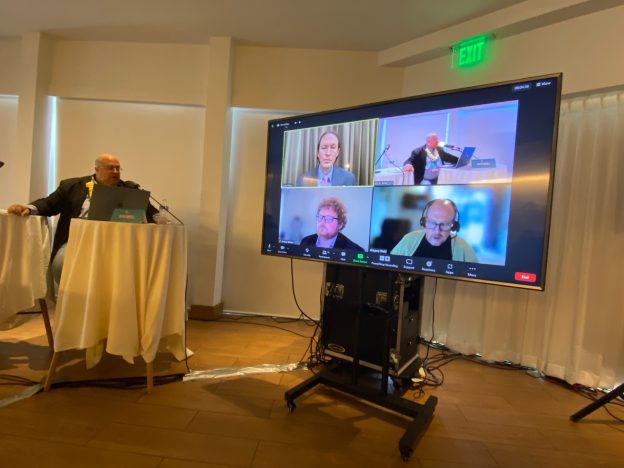L-1ビザの申請は、雇用に基づく非移民および投資家ビザの申請の中で、最も低い承認率となっています。また、L-1申請は、RFE(Request for Evidence)を発行される可能性が最も高い申請でもあります。
2022年度、米国移民局(USCIS)は6件に1件(16.4%)のL-1申請を却下し、申請されたケースの83.6%を承認しています。また、3分の1以上(36.5%)がRFEを発行され、そのうち承認されたのは3分の2以下(65.1%)でした。
まとめると、全L-1申請の36.5%がRFEを発行され、そのうちの3分の1が却下されたことになります。つまり、L-1申請をしてRFEを発行された場合、1/3の確率で却下され、L-1申請の3分の1以上がRFEを受けたのです。
一方、他の雇用ベースのビザ申請の結果は、まったく異なるものとなっています。H-1Bビザの申請については、USCISは全申請の98%を承認し、9.6%にしかRFEを発行しませんでした。Oビザにおいては94.6%を承認し、20.7%にRFEを発行、Pビザは93.2%を承認し、19.6%にRFEを発行、TNビザでは91.4%を承認し、17.4%にRFEを発行しました。在外アメリカ大使館・領事館では、2021年度に92.5%のE-2条約投資家ビザ、及び94.2%のE-1条約貿易家ビザを承認しています。
*各ビザ申請におけるRFE発行率(オレンジ)及び承認率(青)

L-1ビザにより、米国企業は、エグゼクティブ(L-1A)、マネージャー(L-1A)、または専門知識のある従業員(L-1B)を、米国外の関連企業から米国内の関連企業に一時的に転勤させることができます。関連企業であることの条件については別途確認が必要です。またビザ受益者は、基本的に申請直近の過去3年間のうち1年間、主にエグゼクティブ、管理職、または専門的な知識を要する業務に従事していなければなりません。また、同ビザを用いて、米国外の企業が米国に新しい事務所を開設するため、従業員を米国に派遣することもできます。
規則では、L-1ビザが大企業に限定されないことが強調されています。USCISのポリシーマニュアルに記載された例によると、「経理、販売、倉庫、人事」などの非管理職が外部に委託されていれば、「受益者を含め、1人または2人しか雇用されていない」事業体でもよいことになっています。しかし、私たちの経験上、そのようなタイプのケースは最も承認されにくくなっています。 L-1Aを取得するとEB-1Cのグリーンカード(永住権)を取得できる可能性が高くなります。EB-1Cは第1カテゴリーに属し、より早く、またほとんどの国でスムーズに処理されるため、多くの方がL-1Aを取得しようとするようです。
USCISは、L-1申請、特に中小企業のオーナー、トップエグゼクティブまたはマネージャー職のための申請について、非常に多くの質問状(RFE)を発行することで知られています。多くの場合、受益者が米国外でエグゼクティブまたはマネージャーであり、米国でもエグゼクティブまたはマネージャーになれるかどうかを問われます。USCISポリシーマニュアルに「必要以上にビジネスの関係性や受益者の事前および将来の雇用に関する広範な証拠の提出は要求しない」と記載されているにも関わらず、最初の申請でどれほど丁寧な説明をしたり証拠を提出したりしても、申請者の米国外における役職の十分性を問われることは多いのです。
APPROVAL RATES LOWEST AMONG ALL EMPLOYMENT – BASED NONIMMIGRANT PETITIONS
L-1 petitions have the lowest approval rate amongst all employment-based nonimmigrant petitions and investor applications. L-1s are also the most likely to be issued a request for evidence (RFE).
In fiscal year 2022, U.S. Citizenship and Immigration Services (USCIS) denied 1 in 6 (16.4%) L-1 petitions, approving 83.6% of cases filed. More than a third (36.5%) were issued an RFE. Of those issued an RFE, fewer than two thirds (65.1%) were approved.
So, to simplify, 36.5% of all L-1’s were RFE’d and 1/3 of those were denied, so if you receive an RFE for an L-1, there is a 1/3 chance it will be denied and over 1 out of 3 L-1 cases receive an RFE.
Other business petitions have extraordinarily different results: USCIS approved 98% of H-1B petitions and issued RFEs in only 9.6% of the cases; approved 94.6% of O petitions and issued RFEs in 20.7%; approved 93.2% of P petitions and issued RFEs in 19.6%; and approved 91.4% of TN petitions and issued RFEs in 17.1%. Consular posts abroad approved 92.5% of E-2 treaty investor visas and 94.2% of E-1 treaty trader visas in fiscal year 2021.
The L-1 classification enables a U.S. company to temporarily transfer an executive (L-1A), manager (L-1A), or specialized knowledge employee (L-1B), from one of its foreign offices to the United States. The individual must have been working for the foreign entity in a primarily executive, managerial, or specialized knowledge capacity for one year within the preceding three years. The L-1 classification also enables a foreign company to send an employee to the United States to open a new office.
The regulations intimate that L-1s are not limited to large businesses. According to an example in the USCIS Policy Manual, businesses may employ “only one or two people, including the beneficiary,” as long as non-managerial functions, such as “accounting, sales, warehousing, and personnel,” are outsourced. However, our experience has been that those types of cases are the most difficult to be approved. If you obtain an L-1A, there is a good chance you qualify for the EB-1C green card (permanent residence) so many people want to obtain an L-1A since the EB-1C is part of the 1st category so it is much faster and most countries are not backlogged on EB-1 cases.
USCIS is notorious for issuing lengthy requests for evidence (RFEs) on L-1 petitions, particularly on those filed on behalf of owners and top executives or managers of small businesses. Officers often question whether the beneficiary is an executive or manager abroad and will be an executive or manager in the United States. Often no matter what you explain, or document, officers will ask about the person’s qualifications abroad. do so regardless of how well these requirements were documented in the initial petition, and in violation of the USCIS Policy Manual, which states that “[t]he regulations do not require submission of extensive evidence of business relationships or of the beneficiary’s prior and proposed employment.”



